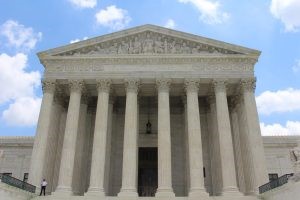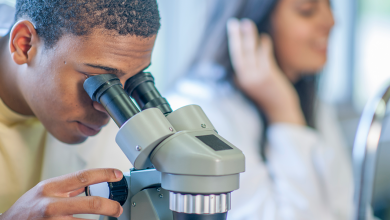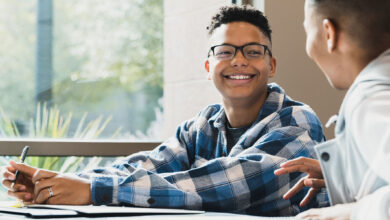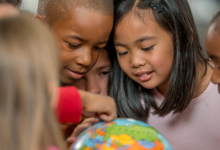
Baltimore City 8th grader makes spatial moves in STEM with launch of bacteria experiment into outer space
By Nicole D. Batey
Morgan Grayson has not yet entered high school and she is already making a profound impact in outer space.
Recently, she and her team, Team Andromeda, were selected as winners of Higher Point’s 2021 Go For Launch! event in Lakeland, Fla.
Together, Morgan and teammates Krysta Fowler, Chelsea Mayfield, Anais Mera-Sarnelli and Autumn Rhodes, created an experiment to study the ‘Effects of Microgravity on a Radiation Resistant Bacteria.”
Team Andromeda’s project was further developed by Space Tango and is scheduled to leave planet Earth on March 14. The project will catch a ride to the International Space Station on the SpaceX CRS-27 from the Kennedy Center in Florida shortly after 8 p.m.
“It feels really surreal to have our project chosen to go into space. I just couldn’t believe it, but I am so excited! I look forward to going to Florida and seeing my teammates—I haven’t seen them in two years,” said Morgan, a student at James McHenry Elementary Middle School in Southwest Baltimore, ahead of traveling to the launch event.
Her parents, Ian “Sonny” and Quianna Grayson couldn’t be prouder.
“As a father, it’s always great to have something to connect with my children over, and for Morgan and that’s math and science,” said Ian Grayson, an engineer. “In the world we live today, there’s a greater demand for STEM. It impacts almost every area of life.”
STEM is an acronym for science, technology, engineering and mathematics.
From an early age, Morgan showed great interest in math and science. Her parents took notice and got Morgan involved in STEM-related extracurricular activities. They also signed her up for programs that would challenge and expose her to various STEM fields.
“I was excited that Morgan wanted to follow in her father’s footsteps with math and science and we wanted to do whatever we could to support her interests. She’s really good at it and it keeps her engaged,” said Quianna Grayson.
Morgan said she believed submitting a project for the competition would allow her to network with others already established in STEM fields.
“My participation with Go For Launch! (GFL!) gave me the opportunity to meet and work with students and professionals who are just as passionate about space exploration as I am,” she said. “I am so excited to be involved with such an awesome project! This is a once in a lifetime experience!”
GFL! is the hands-on flagship program of Higher Orbits, and spotlights the wonders of spaceflight and space exploration. The program aims to provide students across the country the opportunity to develop and strengthen their skills in STEM, teamwork, communication, research design and leadership. While focusing on spaceflight, GFL! students work alongside a featured astronaut at each event to learn and develop important skills that can be applied in any professional field.
At GFL! Lakeland 2021, the students were mentored by and worked alongside veteran NASA astronaut Nicole Stott.
“I’m so excited that Team Andromeda is a Go For Launch!” Stott said. “It was a pleasure working with these young women as they came together as a crew, developed their winning science experiment, and planned their mission. Love to see students like these bringing their dreams to life in space!”
When asked about the importance of Black innovators in STEM, Morgan said representation is key for her.
“I don’t really see a lot of Black women in STEM and I feel like representation is really important for someone like me. Honestly, I haven’t seen a lot of young Black girls doing this.”
According to the U.S. Equal Employment Opportunity Commission’s 2019 Special Topics Annual Report titled, “Women in STEM” :
- Overall, women accounted for 29.3 percent of STEM federal workers. Science occupations had the most (49,546), while math occupations in the federal sector had the fewest number of women (6,469). There were significantly fewer women in Technology and Engineering than expected.
- Most of the women working in STEM in the federal sector were White (66.02 percent). By comparison, 14.58 percent were African American or Black, 9.76 percent Asian, 6.42 percent Hispanic or Latina, 0.97 percent American Indian/Alaska Native, and 0.28 percent Hawaiian or Pacific Islander. In addition, 1.98 percent indicated they were more than one race.
“Math can be so challenging to a number of Black children, so to see Morgan excelling in that space is encouraging to her peers. Representation matters! There is such a great need for representation of Black people in STEM– especially for young Black girls,” said Quianna Grayson.
“As a race, we’re often looked upon by other races as falling behind—that we’re not capable of leading in STEM-related fields,” Quianna Grayson continued. “However, I think more Black women should be involved with STEM to bring their unique perspective to challenges and solutions. It was Morgan’s idea that was selected for the winning team project. She was the youngest on her team at the time at 12 years old. Everyone else was 17 and up, some starting their first year of college, and she was one of two Black girls on her team,” said Sonny Grayson.
Morgan traveled to attend the launch in March in Florida this week, however it has been a costly trip. Her grandmother, Cynthia Reed, set up a Gofundme page to cover expenses for travel and hotel accommodations.
“This is an exciting time and we don’t want her to miss it,” said Reed.
As far as her future plans in STEM, the sky is truly the limit for Morgan, who’s considering whether she wants to be a researcher or an astronomer.
“I want to continue in STEM and research, especially with plants and bacteria. I enjoy finding out about the unknown, and outer space and the oceans are two areas where there is still so much more to explore and discover new things. “To donate to Morgan Grayson’s GofundMe campaign, please visit https://www.gofundme.com/f/launching-morgansproject-into-space.
The post Baltimore City 8th grader makes spatial moves in STEM with launch of bacteria experiment into outer spaceappeared first on AFRO American Newspapers .















